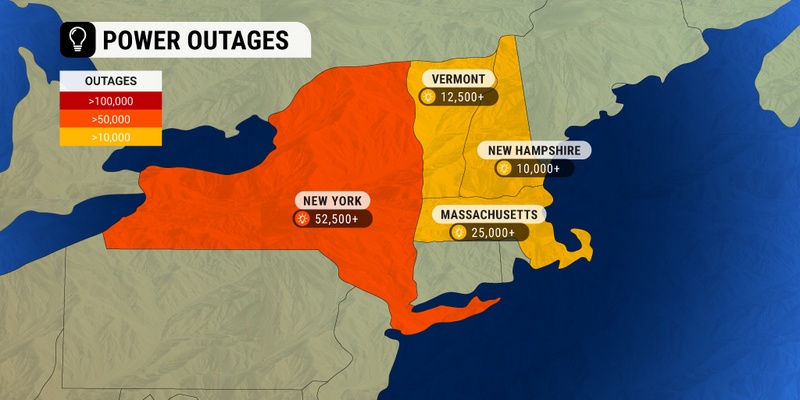
Heavy Rain, Flooding, and Chance of Severe Weather Staring Down the Southern U.S.
January 22, 2024
Posted: March 15, 2023 3:08 pm





The nor’easter is finally wrapping up, however, it has left behind up to 3 feet of snow and thousands without power in its wake. Read on for the latest about this late-season winter storm.
It has been a rough couple of days for many Americans in the Northeast. A robust nor’easter began to impact the area on Monday, creating a variety of disruptions. While there have been no fatalities directly attributed to the storm, officials in Derry, New Hampshire confirmed that 16 emergency officials were called out to respond to a call of a young girl who was trapped under a tree. Rescue crews had to use shovels and chainsaws to free the trapped girl.
Heavy snow pairing with strong winds likely caused the tree to fall. Derry recorded about a foot of snow during the storm. Fortunately, the girl is recovering with only minor injuries.
Rescue crews also responded to a call of two hikers that were stranded on a trail in Mount Washington State Forest, located in southwestern Massachusetts. The hikers called 911 Tuesday evening when they could not retrace their steps and find their out of the park. The hikers were located about six hours after the distress call came in.
Many locations in the Northeast and into New England saw snowfall that hit the 3-foot threshold. Massachusetts, Vermont, and New York all recorded snow in this amount.
Not surprisingly, snow of this magnitude triggered a number of travel disruptions, particularly in the air. Over 2,000 flights were cancelled with more than 1,000 delayed. The highest number of disruptions happened at Boston Logan International, LaGuardia Airport, John F. Kennedy International Airport, and Bradley International Airport in Connecticut.
Roads were also rendered impassable in some areas because of the heavy and drifting snow. A portion of the northbound lane of Interstate 95 between New Hampshire and Maine was briefly shut down because of dicey conditions. There were also a variety of speed advisory limits and commercial vehicle bans levied on some portions of the Garden State Parkway in New Jersey, Interstate 84, and Interstate 87.
New Hampshire was hit particularly hard by the nor’easter. State police troopers said that they responded to over 200 incidents on Tuesday alone. In addition, over 70 communities in the state had to postpone the scheduled elections. Police officers across the state also lended a hand and drove voters in need to polling elections.
Gusty winds were also an issue with this nor’easter. A gust of 71 mph was reported on Tuesday in Frenchboro, Maine, an island located south of Bangor. Bangor itself recorded a gust of over 50 mph.
The beach resort town of Atlantic City, New Jersey recorded a gust of 62 mph while a town in western Long Island saw winds hit nearly 60 mph.
This wind undoubtedly created widespread power outages. At least 300,000 customers were in the dark across New York, New Hampshire, Vermont, Maine, and Massachusetts by late Tuesday. The highest number of outages were reported in the eastern portion of New York state.
It was a bitterly cold start to the day Wednesday in the wake of the storm. Real feel readings in the cities of New York City, Boston, Washington, D.C., and Boston dropped down into the 20s. Even colder readings were reported in the interior of the Northeast and New England. For instance, Burlington, Vermont came in with a real feel of 14 degrees on Wednesday morning as light snow lingered.
A warmup is on the way for the region after the nor’easter exits. A large area of high pressure is forecast to become the pervading weather influence in the coming days, bringing the mercury up above freezing. This high pressure will also clear the way for dry conditions.
You can count on this settled weather through Thursday and much of Friday. However, the arrival of a new cold front later Friday will bring the return of the moisture. Warmer temperatures should keep any precipitation falling as rain rather than snow for the bulk of the region.
Did you find this content useful? Feel free to bookmark or to post to your timeline for reference later.

January 21, 2024

January 19, 2024

January 18, 2024